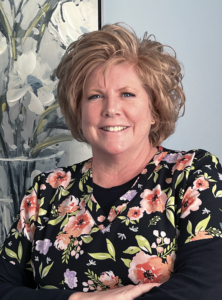Breaking Down Barriers to End-of-Life Support
 By Kristine Crockett, RN, CHPN, Director of Homeland Hospice and Homeland Palliative Care. Kristine has been providing compassionate end-of-life care as a hospice nurse for more than 25 years and provides a wealth of knowledge and experience to those she is leading as the director. Kristine is an Army Veteran having served in the military for over nine years as a military police and corrections officer. She enjoys spending time with her family and friends at gatherings and vacations on the lake, as well as helping out her staff and finding ways to support fellow Veterans whenever possible.
By Kristine Crockett, RN, CHPN, Director of Homeland Hospice and Homeland Palliative Care. Kristine has been providing compassionate end-of-life care as a hospice nurse for more than 25 years and provides a wealth of knowledge and experience to those she is leading as the director. Kristine is an Army Veteran having served in the military for over nine years as a military police and corrections officer. She enjoys spending time with her family and friends at gatherings and vacations on the lake, as well as helping out her staff and finding ways to support fellow Veterans whenever possible.
Hospice care is a vital resource designed to provide compassionate support to individuals facing life-limiting illnesses. However, despite its benefits, hospice remains significantly underutilized in many communities. This trend raises important questions about why individuals and families may not be accessing this valuable service when they need it most.
One key factor contributing to the underutilization of hospice care is a lack of awareness and understanding. Many people are unfamiliar with hospice and may mistakenly believe that it is only appropriate for individuals in the final days or weeks of life. Hospice care is most effective when accessed earlier in the journey of a life-limiting illness, allowing patients and their families to benefit from comprehensive support, pain management, and emotional care for a longer duration.
Furthermore, cultural and societal attitudes toward death and dying play a significant role in shaping perceptions of hospice care. In some cultures, discussions about death may be considered taboo or uncomfortable, leading individuals to avoid conversations about end-of-life care until it becomes unavoidable. This reluctance to confront mortality can prevent individuals from seeking hospice services until it is too late to fully benefit from them.
Financial concerns also contribute to the underutilization of hospice care. While hospice services are typically covered by Medicare, Medicaid, and most private insurance plans, some individuals may be unaware of their coverage options or may be reluctant to incur additional expenses related to end-of-life care. This financial barrier can prevent individuals from accessing hospice services until their illness has progressed to a point where the benefits of hospice may be limited.
Additionally, healthcare provider attitudes and practices can influence the utilization of hospice care. Some healthcare professionals may be hesitant to broach the topic of hospice with patients and their families, fearing that it may be perceived as giving up hope or admitting defeat. This reluctance to discuss end-of-life care options can delay access to hospice services and limit the ability of patients and their families to make informed decisions about their care.
Addressing the underutilization of hospice care requires a multifaceted approach that involves raising awareness, promoting cultural competence, addressing financial barriers, and improving communication between healthcare providers and patients. Education campaigns aimed at dispelling myths and misconceptions about hospice can help individuals and families understand the benefits of early intervention and comprehensive end-of-life support.
Healthcare providers should receive training on how to initiate conversations about hospice care in a compassionate and sensitive manner, ensuring that patients and their families are fully informed about their options. By addressing these barriers, we can work towards ensuring that all individuals facing life-limiting illnesses have access to the support and care they need to live their final days with dignity and comfort.
National Cancer Institute. Choices for Care When Treatment May Not be an Option
Medicare.gov.Hospice care
Shalev A, Phongtankuel, Kozlov E, Shen MH, Adelmand R, Reid MC. Awareness and misperceptions of hospice and palliative care: A population-based survey study. Am J Hosp Palliative Care. 2018 Mar; 35(3):431-439. Doi:10.1177/1049909117715215


